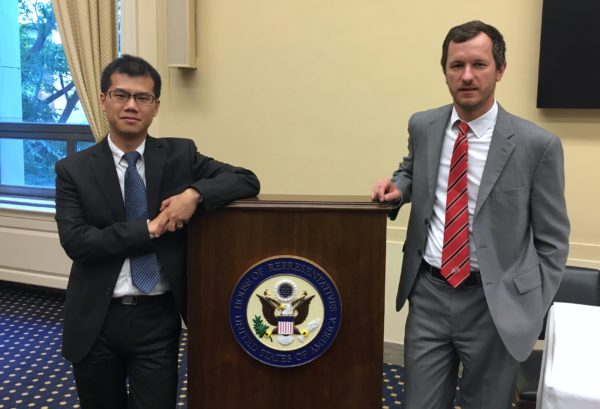by Ashley White, Berkeley Lab – original story
A panel of light source users participated in a briefing for Capitol Hill staff on July 26. The event, hosted by the U.S. House and Senate National Laboratory Caucuses, highlighted the critical role DOE x-ray light source user facilities play in advancing new technologies, the challenges posed by increasing international competition from Europe and Asia, and how next-generation upgrades to these facilities will open new scientific frontiers. Briefings are often provided in a panel presentation and discussion format, and offer the opportunity to educate Capitol Hill staffers in a less formal setting than a hearing and in greater numbers than individual office visits allow. Pictured is ALS User Will Chueh (Stanford University) presenting his work on batteries, with Mike Czabaj (University of Utah) on the far right.
The panel featured academic and industry users from the four DOE-supported synchrotron light sources—the ALS, the Advanced Photon Source at Argonne, the National Synchrotron Light Source II at Brookhaven, and the Stanford Synchrotron Radiation Lightsource at SLAC. The briefing opened with an overview of DOE’s x-ray light sources provided by Harriet Kung, associate director of science for DOE’s Basic Energy Sciences program. Following her introduction, panelists Brian Landes (Dow Chemical Company), Stan Petrash (Henkel Corporation), William Chueh (Stanford University), Michael Czabaj (University of Utah), and Anthony Rollett (Carnegie Mellon University) gave examples of how access to these user facilities has impacted their work. Toby Smith, vice president for policy for the Association of American Universities, moderated the discussion.
Chueh and Czabaj focused most heavily on specific impacts of the ALS in their remarks. Chueh talked about the ALS’s ability to image lithium-ion battery particles in operation and demonstrated the experimental results with a movie. “You can see the motions of atoms in the battery, as it charges and discharges,” said Chueh. He also spoke about the role of light sources in developing safer, more cost effective, and longer-lasting batteries, citing a three-fold improvement in energy density over the last 26 years and a more than six-fold decrease in cost over the last decade driven by understanding the fundamental science behind the battery. He also highlighted the importance of “strong and timely” collaborations—between users and the facility scientists and between university and industry users—to enabling the science and American leadership and technological development.
Czabaj discussed microtomography experiments he’s conducting on composite materials as part of an Approved Program in collaboration with UC Berkeley, GE Global Research, GE Aviation, Teledyne Scientific, and the Air Force Research Laboratory. He uses a so-called “hot cell” to mechanically test materials under simulated operating conditions, including high temperature, in real time, in three dimensions, and at tiny length scales. “This technique has had an incredible impact on the aerospace industry, specifically on materials discovery, space exploration, and sustainment of our current fleet of commercial and military aircraft,” he said.
The Q&A focused on the unique features of each of the four DOE light sources, the demand for access to the light sources, the relationship between basic and applied research at the light sources, and the need for next-generation upgrades. In response to the first question, Kung explained, “The light sources each cover different spectral regions and do different things. Their resources are tailored for different types of sciences,” Petrash pointed to two types of materials Henkel develops—adhesives and metals. For adhesives, which are soft, polymeric materials, “We need to use soft x-rays that are less damaging and can characterize lighter elements like carbon,” said Petrash. “But with metals, which are a much denser material, you need a higher-energy synchrotron.” He also noted that, “Many of our projects combine results from two or three different synchrotrons to put together all the pieces of the puzzle.”

The panelists generally agreed that access to the light sources can be challenging in some cases, due to large demand and limited capacity. “At some of the more competitive beamlines, we’re turning down four out of five proposals,” said Kung. Even for those that get access, they find they have to carefully choose their experiments to fit into the beam time allotted. “The upgrades will hopefully help a lot, since they’ll increase the intensity by two or three orders of magnitude,” explained Kung, and brighter light means that some experiments can be performed more quickly.
In discussing basic and applied research connections and the need for upgrades, Chueh pointed to a goal that Ford Motor Company would like to reach, of charging an electric vehicle battery in a matter of minutes. “It’s not something we appreciate in academia to be so important. We might be happy with one hour. When we start interacting with industry, we learn what’s important,” said Chueh. He also leveraged the example to explain what the ALS Upgrade (ALS-U) could offer. He pointed out that the movie he showed earlier in the session took five hours of data collection to produce, which is a limitation for studying supercharging that companies like Ford are interested in. But ALS-U’s greatly increased flux could accomplish the experiment in a hundredth of the time. “Rather than doing the experiment at the rate of academic interest, we’ll be able to do it for academic and industrial interest.”